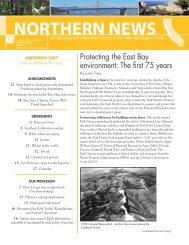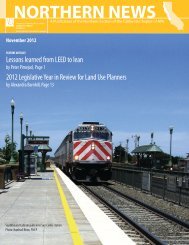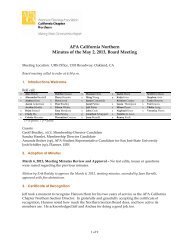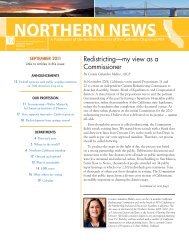Layout 1 - Northern California Chapter of the American Planning ...
Layout 1 - Northern California Chapter of the American Planning ...
Layout 1 - Northern California Chapter of the American Planning ...
Create successful ePaper yourself
Turn your PDF publications into a flip-book with our unique Google optimized e-Paper software.
Meet a local plannerThird in a series <strong>of</strong> interviews by Tania Sheyner, AICPKen MacNab is <strong>the</strong> <strong>Planning</strong> Managerfor <strong>the</strong> City <strong>of</strong> Napa, where he’s beenemployed since last fall.How did you become interestedin planning?I became interested in planning when aproperty that I spent a lot <strong>of</strong> time on as ayouth was proposed for development. I didn’tunderstand why this open space, which had always been accessibleto <strong>the</strong> public, could suddenly be developed. But, <strong>of</strong> course, it wasreally a privately owned parcel. I followed <strong>the</strong> public processfor that development, which inspired me to pursue a career inpreserving open space. I attended <strong>the</strong> planning program at SonomaState University, where I was introduced to planning concepts likesmart growth, transit-oriented development, and urban growthboundaries, and realized that a more effective way to preserve openspace would be to work on focusing growth and development inurban areas.What’s unique about planning in Napa?I love <strong>the</strong> scale, geography, and location <strong>of</strong> Napa. As a planner,it’s a really exciting time to be working here. Napa has experiencedtremendous success in revitalizing its downtown and riverfrontareas and is fortunate to have developers coming forward with greatprojects that will build <strong>of</strong>f this success. One <strong>of</strong> <strong>the</strong> main challengesin Napa is balancing a community that draws a lot <strong>of</strong> tourists with<strong>the</strong> needs <strong>of</strong> local residents. While economic development andtourism are important, it is equally important to maintain a livable,friendly community for <strong>the</strong> residents.SPUR’s work in San Jose is heatingup. Check out <strong>the</strong> great article featuredin this month’s Urbanist on <strong>the</strong> past andfuture <strong>of</strong> San Jose’s downtown as anurban center for Silicon Valley.http://bit.ly/YBmAzDCan you describe <strong>the</strong> changes in <strong>the</strong> planning fieldyou’ve witnessed over <strong>the</strong> years?A big one is <strong>the</strong> introduction <strong>of</strong> technology. Tools such as <strong>the</strong>Internet and GIS have had a huge, positive influence on <strong>the</strong> field,have facilitated analysis, and have provided instantaneous accessto information. In <strong>the</strong> Bay Area specifically, <strong>the</strong>re has been anincreasing emphasis on regional planning. I have also seen anincreasing emphasis on sustainability — particularly at <strong>the</strong> statelevel <strong>of</strong> government. Ano<strong>the</strong>r area that has changed is <strong>the</strong> loss<strong>of</strong> redevelopment.What advice would you give planners starting out?Find a mentor. Having a mentor who has been in <strong>the</strong> planningfield for many years and has experienced <strong>the</strong> challenges anddecisions that a planner faces over <strong>the</strong> course <strong>of</strong> a career is a greatresource. I can ask questions or seek advice on issues that I may(continued on next page)<strong>Nor<strong>the</strong>rn</strong> News 5 May 2013





![[NAME OF EVENT] EVALUATION FORM](https://img.yumpu.com/32351925/1/190x245/name-of-event-evaluation-form.jpg?quality=85)

